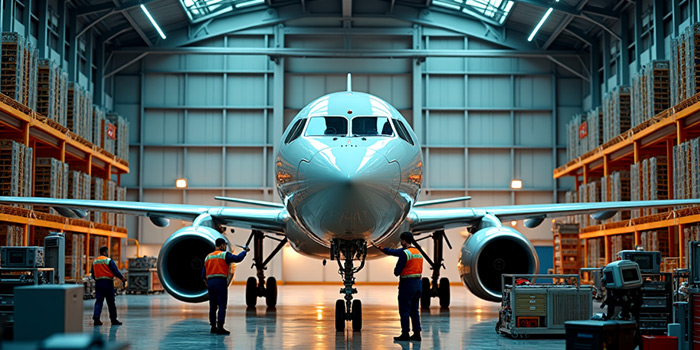From Reactive to Predictive: How Digital Twins & Predictive Maintenance Are Revolutionizing MRO
03 Oct 2025
Highlights:
The world of Maintenance, Repair, and Overhaul (MRO) is undergoing a profound transformation. No longer confined to reactive responses, MRO operations are becoming increasingly predictive, leveraging AI-driven digital twins and the Internet of Things (IoT) to optimize maintenance planning and reduce costly downtime.

The Digital Twin & IoT Advantage
At its core, a digital twin is a dynamic, real-time virtual replica of a physical asset—be it an engine, landing gear, or entire aircraft. Constant IoT sensor feeds, historical data, and operational inputs keep the twin updated, enabling simulations, health monitoring, and what-if scenario testing. This not only enhances decision-making but shifts the industry from scheduled, reactionary maintenance to more strategic, condition-based approaches.
Market Momentum & Technology Penetration
The momentum behind digital solutions in MRO is clear:
- The digital MRO market was valued at USD 1.20 billion in 2024, projected to reach USD 3.77 billion by 2034, growing at a CAGR of 12.13 %
- Another projection pegs the market at USD 2.4 billion in 2024, surging to USD 4.5 billion by 2030, with a CAGR of 11.2 %
- By 2023, predictive maintenance captured the largest slice—approximately 27 % of the digital MRO market share
Measurable Benefits with Digital Twins & AI
Major industry players are reporting impressive results:
• GE Aerospace: With AI/ML-powered digital twins, they’ve achieved:
- 60 % earlier detection of preventive maintenance needs,
- A 45 % increase in detection accuracy,
- And reduced false alerts by 50 % over the past decade
• Deloitte estimates that predictive maintenance rollout can yield:
- 15 % reduction in downtime,
- 20 % gain in labor productivity
• A McKinsey study suggests:
- 18–25 % lower maintenance costs,
- 5–15 % improvement in asset availability
Broader IoT & IIoT Impact
Even beyond aviation, Industrial IoT (IIoT) platforms are showing promise:
• Predictive maintenance enabled by IIoT can slash scheduled repair costs by up to 12 %, reduce overall maintenance costs by up to 30 %, and eliminate equipment breakdowns by up to 70 %
Strategic Workflow Enhancements
Integrating digital twins and AI isn’t just about condition monitoring—it’s about strategy:
- AI-powered simulations allow MRO teams to compare real-time performance against virtual baselines, run predictive scenarios (e.g., turbine blade wear based on temperature), and make data-driven adjustments
- In inventory management, AI forecasts parts demand by analyzing historical usage, flight schedules, and failure patterns—helping strike the right balance between stock availability and cost efficiency
- AI also helps automate maintenance planning, generating optimized work schedules considering technician availability, urgency, regulatory constraints, and part delivery timelines
The Operational Shift: Reactive → Predictive → Prescriptive
The integration of digital twins into MRO is catalyzing a shift not just in operations, but in strategy:
- Reactive maintenance—fixing what has failed—is being replaced by predictive maintenance, which anticipates potential failures.
- The next frontier is prescriptive maintenance—where systems not only forecast issues but also recommend exact steps to resolve them
Final Thoughts
Digital twins, reinforced by AI and IoT, are ushering in a new paradigm in MRO. From reducing downtime and boosting efficiency to enabling smarter strategic planning, this technology is transforming maintenance from a costly necessity into a competitive advantage. As adoption grows, MRO organizations that embrace digital transformation stand to gain not just operational savings but lasting leadership in a data-driven future.
Sources
- Investments in digital twin technologies projected to exceed USD 48 billion by 2026; increased airline and MRO adoption LinkedIn
- Deloitte: Predictive maintenance outcomes—15 % downtime reduction, 20 % labor productivity gain; McKinsey: 18–25 % cost savings, 5–15 % availability improvement LinkedIn
- Global Digital MRO Market valued at USD 1.20 billion in 2024, projecting to USD 3.77 billion by 2034; predictive maintenance segment at 22.5 % sharePrecedence Research
- Digital MRO market forecast: USD 2.4 billion (2024) to USD 4.5 billion (2030), CAGR 11.2 % Strategic Market Research
- Predictive maintenance accounted for ≈27 % of digital MRO market in 2023; airlines fastest-growing end-user segment GlobeNewswire Global Market Insights Inc.
- GE’s AI/ML digital twin results: 60 % earlier lead time, 45 % detection increase, 50 % fewer false alerts Aviation Business News
- IIoT benefits: 12 % savings on scheduled repairs, 30 % less maintenance cost, 70 % fewer breakdowns Wikipedia
- AI-driven digital twin capabilities: simulation, inventory optimization, workflow automation MarketsandMarkets
- Evolution toward prescriptive maintenance; potential savings and efficiency with AI Business Insider LinkedIn
AviaPro Newsroom
+1 416-544-9969
info@aviaproconsulting.com

Editorial Contacts